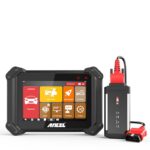Locating the OBD2 port in your BMW can sometimes feel like a mini treasure hunt. While all modern vehicles, including BMWs, are equipped with an On-Board Diagnostics port (OBD2) to access vital car data, its exact location isn’t always immediately obvious. This standardized 16-pin connector is your gateway to understanding your BMW’s health, allowing you to diagnose issues, monitor performance, and much more using diagnostic tools. If you’re looking to connect a scanner to your BMW, the first step is knowing where to find this crucial port.
Why is Finding Your BMW OBD2 Port Important?
The OBD2 port is essential for modern car diagnostics. It allows mechanics and car owners to interface with the vehicle’s computer system. By plugging an OBD2 scanner into this port, you can read diagnostic trouble codes (DTCs) to understand what might be wrong when your check engine light comes on. Beyond just error codes, the OBD2 port provides access to a wealth of real-time data about your BMW’s engine, transmission, and other systems. This data is invaluable for troubleshooting problems, performing routine maintenance, and even enhancing your car’s performance. Whether you’re a seasoned mechanic or a BMW owner keen on understanding your vehicle better, knowing your Bmw Obd2 Port Location is the starting point for effective car diagnostics.
Common BMW OBD2 Port Locations
While the OBD2 port is mandated to be within the passenger compartment of all vehicles, BMW, like other manufacturers, has some common placement areas, but the exact spot can vary depending on the model and year. Generally, you should start your search in these locations:
- Under the Dashboard (Driver’s Side): This is the most frequent location. Look beneath the steering wheel column, often near the pedals or towards the center console. It might be exposed or hidden behind a small cover.
- Glove Box Area: In some BMW models, the OBD2 port is located within or above the glove box compartment. Check inside the glove box or in the area directly above it.
- Center Console: Less commonly, but possible, the port could be situated in the center console, either in the front section or under the armrest.
Keep in mind that the port might be subtly tucked away and may not be immediately visible. You might need to get down and look closely in these areas.
BMW OBD2 Port Locations by Model
To make your search easier, here’s a list of BMW OBD2 port locations based on different series and models. This is based on community knowledge and general locations; always double-check your specific model’s manual if you’re unsure.
- 1 Series: E87, F20, F40 – Typically under the dashboard, driver’s side.
- 2 Series: F22, F45, F46 – Usually located under the dashboard on the driver’s side.
- 3 Series: E36, E46, E90, F30, G20 – Mostly found under the dashboard, driver’s side. For some older E46 models, it might be in the glove box.
- 4 Series: F32/F33/F36 – Under the dashboard, driver’s side is the common placement.
- 5 Series: E34, E39, E60, F10/F11, G30/G31 – Commonly under the dashboard, driver’s side. Older E39 models might have it near the center console or under the hood in rare cases (though less likely for OBD2).
- 6 Series: E63/E64, G32 – Typically under the dashboard, driver’s side.
- 7 Series: E38, E65/E66/E67/E68, F01/F02, G11/G12 – Usually under the dashboard, driver’s side.
- X Series (SUVs):
- X1 E84, F48 – Under the dashboard, driver’s side.
- X2 – Likely under the dashboard, driver’s side.
- X3 E83, F25, G01 – Commonly under the dashboard, driver’s side.
- X4 F26, G02 – Usually under the dashboard, driver’s side.
- X5 E53, E70, F15, G05 – Mostly under the dashboard, driver’s side. E70 RHD might vary slightly.
- X6 E71 – Under the dashboard, driver’s side.
- Z Series (Roadsters):
- Z3, Z4 E85, Z4 E89 – Usually under the dashboard, driver’s side.
- i Series (Electric Vehicles):
- i3 I01, i4, i8 – Likely under the dashboard, driver’s side, consistent with other BMW models.
It’s important to note that “RHD” (Right Hand Drive) models, common in countries like the UK and Australia, might have the OBD2 port in a mirrored location, still typically under the dashboard but on the driver’s side which would be the right side of the car.
Using Your OBD2 Port for Diagnostics
Once you’ve located your BMW OBD2 port, you can use a compatible OBD2 scanner to read diagnostic codes, check engine lights, access live data, and perform various diagnostic tests. For BMW specific diagnostics, consider using scanners that offer advanced features and compatibility with BMW systems. Software solutions are also available that can be used in conjunction with OBD2 scanners to provide in-depth analysis and vehicle insights.
Still Can’t Find It?
If you’ve checked the common locations and still can’t find the OBD2 port in your BMW, here are a few additional tips:
- Consult Your Owner’s Manual: Your BMW owner’s manual is the definitive guide for your specific model. Look for a section on diagnostics or OBD ports.
- Use a Flashlight: Sometimes the port is in a dimly lit area, making it harder to spot. A flashlight can help illuminate the area under the dashboard.
- Feel Around: If you can’t see it, carefully feel under the dashboard and around the steering column area. The port has a distinct 16-pin connector shape.
- Online BMW Forums: BMW enthusiast forums online can be a great resource. Search for your specific BMW model and year, and you’ll likely find threads discussing OBD2 port locations.
Finding your BMW OBD2 port location is usually straightforward with these guidelines. Once located, you unlock a powerful tool for understanding and maintaining your BMW, ensuring it runs smoothly for years to come.
Looking for OBD2 port locations for other German car brands? We’ve got you covered:
Audi | [
